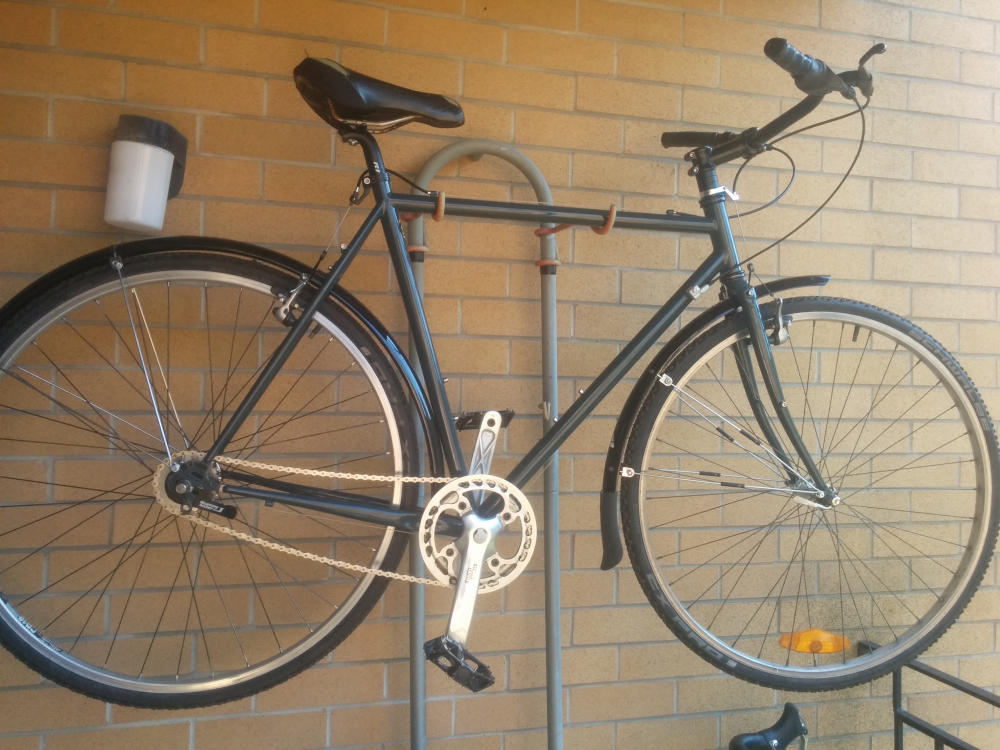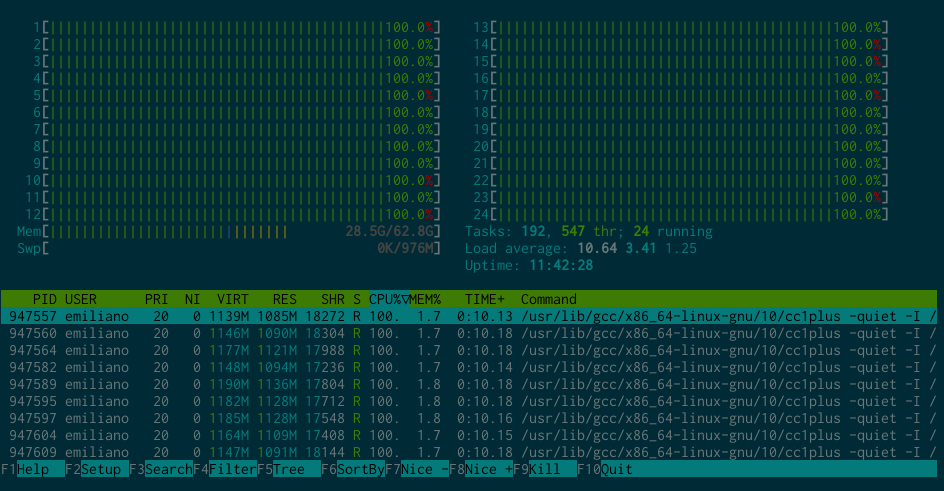
I have been a Puppet user for a couple of years now, first at work, and
eventually for my personal servers and computers. Although it can have a steep
learning curve, I find Puppet both nimble and very powerful. I also prefer it
to Ansible for its speed and the agent-server model it uses.
Sadly, Puppet Labs hasn't been the most supportive upstream and tends to move
pretty fast. Major versions rarely last for a whole Debian Stable release and
the upstream
.deb packages are full of vendored libraries.
Since 2017, Apollon Oikonomopoulos has been the one doing most of the work on
Puppet in Debian. Sadly, he's had less time for that lately and with Puppet 5
being deprecated in January 2021, Thomas Goirand, Utkarsh Gupta and I have been
trying to package Puppet 6 in Debian for the last 6 months.
With Puppet 6, the old ruby Puppet server using Passenger is not supported
anymore and has been replaced by
puppetserver, written in Clojure and running
on the JVM. That's quite a large change and although
puppetserver does reuse
some of the Clojure libraries
puppetdb (already in Debian) uses, packaging it
meant quite a lot of work.
Work in the Clojure team
As part of my efforts to package
puppetserver, I had the pleasure to join the
Clojure team and learn a lot about the Clojure ecosystem.
As I mentioned earlier, a lot of the Clojure dependencies needed for
puppetserver were already in the archive. Unfortunately, when Apollon
Oikonomopoulos packaged them, the
leiningen build tool hadn't been packaged
yet. This meant I had to rebuild a lot of packages, on top of packaging some
new ones.
Since then, thanks to the efforts of Elana Hashman,
leiningen has been
packaged and lets us run the upstream testsuites and create
.jar artifacts
closer to those upstream releases.
During my work on
puppetserver, I worked on the following packages:
List of packages
backport9bidi-clojureclj-digest-clojureclj-helperclj-time-clojureclj-yaml-clojurecljx-clojurecore-async-clojurecore-cache-clojurecore-match-clojurecpath-clojurecrypto-equality-clojurecrypto-random-clojuredata-csv-clojuredata-json-clojuredata-priority-map-clojurejava-classpath-clojurejnr-constantsjnr-enxiojrubyjruby-utils-clojurekitchensink-clojurelazymap-clojureliberator-clojureordered-clojurepathetic-clojurepotemkin-clojureprismatic-plumbing-clojureprismatic-schema-clojurepuppetlabs-http-client-clojurepuppetlabs-i18n-clojurepuppetlabs-ring-middleware-clojurepuppetserverraynes-fs-clojureriddley-clojurering-basic-authentication-clojurering-clojurering-codec-clojureshell-utils-clojuressl-utils-clojuretest-check-clojuretools-analyzer-clojuretools-analyzer-jvm-clojuretools-cli-clojuretools-reader-clojuretrapperkeeper-authorization-clojuretrapperkeeper-clojuretrapperkeeper-filesystem-watcher-clojuretrapperkeeper-metrics-clojuretrapperkeeper-scheduler-clojuretrapperkeeper-webserver-jetty9-clojureurl-clojureuseful-clojurewatchtower-clojure
If you want to learn more about packaging Clojure libraries and applications,
I rewrote the Debian Clojure
packaging tutorial and added a section
about the quirks of using
leiningen without a dedicated
dh_lein tool.
Work left to get puppetserver 6 in the archive
Unfortunately, I was not able to finish the
puppetserver 6 packaging work.
It is thus unlikely it will make it in Debian Bullseye. If the issues described
below are fixed, it would be possible to to package
puppetserver in
bullseye-backports though.
So what's left?
jruby
Although I tried my best (kudos to Utkarsh Gupta and Thomas Goirand for the
help),
jruby in Debian is still broken. It does build properly, but the
testsuite fails with multiple errors:
ruby-psych is broken (#959571)- there are some random java failures on a few tests (no clue why)
- tests ran by
raklelib/rspec.rake fail to run, maybe because the --pattern
command line option isn't compatible with our version of rake? Utkarsh seemed
to know why this happens.
jruby testsuite failures aside, I have not been able to use the
jruby.deb the
package currently builds in
jruby-utils-clojure (testsuite failure). I had the
same exact failure with the (more broken)
jruby version that is currently in
the archive, which leads me to think this is a
LOAD_PATH issue in
jruby-utils-clojure. More on that below.
To try to bypass these issues, I
tried to vendor jruby into
jruby-utils-clojure. At first I understood
vendoring meant including
upstream pre-built artifacts (
jruby-complete.jar) and shipping them directly.
After talking with people on the
#debian-mentors and
#debian-ftp IRC
channels, I now understand why this isn't a good idea (and why it's not
permitted in Debian). Many thanks to the people who were patient and kind enough
to discuss this with me and give me alternatives.
As far as I now understand it,
vendoring in Debian means "to have an embedded
copy of the source code in another package". Code shipped that way still needs
to be built from source. This means we need to build
jruby ourselves, one way
or another.
Vendoring jruby in another package thus isn't terribly helpful.
If fixing
jruby the proper way isn't possible, I would suggest trying to
build the package using embedded code copies of the external libraries
jruby
needs to build, instead of trying to use the Debian libraries.
This
should make it easier to replicate what upstream does and to have a final
.jar that can be used.
jruby-utils-clojure
This package is a first-level dependency for
puppetserver and is the glue
between
jruby and
puppetserver.
It builds fine, but the testsuite fails when using the Debian
jruby package. I
think the problem is caused by a
jruby LOAD_PATH issue.
The Debian
jruby package plays with the
LOAD_PATH a little to try use
Debian packages instead of downloading gems from the web, as upstream
jruby
does. This seems to clash with the
gem-home,
gem-path, and
jruby-load-path variables in the
jruby-utils-clojure package. The testsuite
plays around with these variables and some Ruby libraries can't be found.
I tried to fix this, but failed. Using the upstream
jruby-complete.jar instead
of the Debian
jruby package, the testsuite passes fine.
This package could clearly be uploaded to NEW right now by ignoring the
testsuite failures (we're just packaging static
.clj source files in the
proper location in a
.jar).
puppetserver
jruby issues aside, packaging puppetserver itself is 80% done. Using the
upstream
jruby-complete.jar artifact, the testsuite fails with a weird
Clojure error I'm not sure I understand, but I haven't debugged it for very
long.
Upstream uses git submodules to vendor puppet (agent), hiera (3), facter and
puppet-resource-api for the testsuite to run properly. I haven't touched that,
but I believe we can either:
- link to the Debian packages
- fix the Debian packages if they don't include the right files (maybe in a new
binary package that just ships part of the source code?)
Without the testsuite actually running, it's hard to know what files are needed
in those packages.
What now
Puppet 5 is now deprecated.
If you or your organisation cares about Puppet in Debian,
puppetserver
really isn't far away from making it in the archive.
Very talented Debian Developers are always eager to work on these issues and
can be contracted for very reasonable rates. If you're interested in
contracting someone to help iron out the last issues, don't hesitate to reach
out via one of the following:
As for I, I'm happy to say I got a new contract and will go back to teaching
Economics for the Winter 2021 session. I might help out with some general Debian
packaging work from time to time, but it'll be as a hobby instead of a job.
Thanks
The work I did during the last 6 weeks would be not have been possible without
the support of the Wikimedia Foundation, who were gracious enough to contract
me. My particular thanks to Faidon Liambotis, Moritz M hlenhoff and John Bond.
Many, many thanks to Rob Browning, Thomas Goirand, Elana Hashman, Utkarsh Gupta
and Apollon Oikonomopoulos for their direct and indirect help, without which
all of this wouldn't have been possible.
 I've been teaching economics for a few semesters already and, slowly but
surely, I'm starting to get the hang of it. Having to deal with teaching
remotely hasn't been easy though and I'm really hoping the winter semester will
be in-person again.
Although I worked way too much last semester1, I somehow managed to
transition to using a graphics tablet. I bought a Wacom Intuos S tablet (model
CTL-4100) in late August 2021 and overall, I have been very happy with it.
Wacom Canada offers a small discount for teachers and I ended up paying 115 CAD
(~90 USD) for the tablet, an overall very reasonable price.
Unsurprisingly, the Wacom support on Linux is very good and my tablet worked
out of the box. The only real problem I had was by default, the tablet
sometimes boots up in Android mode, making it unusable. This is easily solved
by pressing down on the pad's first and last buttons for a few seconds, until
the LED turns white.
The included stylus came with hard plastic nibs, but I find them too slippery.
I eventually purchased hard felt nibs, which increase the friction and makes
for a more paper-like experience. They are a little less durable, but I wrote
quite a fair bit and still haven't gone through a single one yet.
Learning curve
Learning how to use a graphical tablet took me at least a few weeks! When
writing on a sheet of paper, the eyes see what the hand writes directly. This
is not the case when using a graphical tablet: you are writing on a surface and
see the result on your screen, a completely different surface. This dissociation
takes a bit of practise to master, but after going through more than 300 pages
of notes, it now feels perfectly normal.
Here is a side-by-side comparison of my very average hand-writing2:
I've been teaching economics for a few semesters already and, slowly but
surely, I'm starting to get the hang of it. Having to deal with teaching
remotely hasn't been easy though and I'm really hoping the winter semester will
be in-person again.
Although I worked way too much last semester1, I somehow managed to
transition to using a graphics tablet. I bought a Wacom Intuos S tablet (model
CTL-4100) in late August 2021 and overall, I have been very happy with it.
Wacom Canada offers a small discount for teachers and I ended up paying 115 CAD
(~90 USD) for the tablet, an overall very reasonable price.
Unsurprisingly, the Wacom support on Linux is very good and my tablet worked
out of the box. The only real problem I had was by default, the tablet
sometimes boots up in Android mode, making it unusable. This is easily solved
by pressing down on the pad's first and last buttons for a few seconds, until
the LED turns white.
The included stylus came with hard plastic nibs, but I find them too slippery.
I eventually purchased hard felt nibs, which increase the friction and makes
for a more paper-like experience. They are a little less durable, but I wrote
quite a fair bit and still haven't gone through a single one yet.
Learning curve
Learning how to use a graphical tablet took me at least a few weeks! When
writing on a sheet of paper, the eyes see what the hand writes directly. This
is not the case when using a graphical tablet: you are writing on a surface and
see the result on your screen, a completely different surface. This dissociation
takes a bit of practise to master, but after going through more than 300 pages
of notes, it now feels perfectly normal.
Here is a side-by-side comparison of my very average hand-writing2:
 I still prefer the result of writing on paper, but I think this is mostly due to
me not using the pressure sensitivity feature. The support in
I still prefer the result of writing on paper, but I think this is mostly due to
me not using the pressure sensitivity feature. The support in  Use case
The first use case I have for the tablet is grading papers. I've been asking my
students to submit their papers via Moodle for a few semesters already, but
until now, I was grading them using PDF comments. The experience wasn't
great3 and was rather slow compared to grading physical copies.
I'm also a somewhat old-school teacher: I refuse to teach using slides. Death
by PowerPoint is real. I write on the blackboard a lot4 and I find
it much easier to prepare my notes by hand than by typing them, as the end
result is closer to what I actually end up writing down on the board.
Writing notes by hand on sheets of paper is a chore too, especially when you
revisit the same materiel regularly. Being able to handwrite digital notes gives
me a lot more flexibility and it's been great.
So far, I have been using
Use case
The first use case I have for the tablet is grading papers. I've been asking my
students to submit their papers via Moodle for a few semesters already, but
until now, I was grading them using PDF comments. The experience wasn't
great3 and was rather slow compared to grading physical copies.
I'm also a somewhat old-school teacher: I refuse to teach using slides. Death
by PowerPoint is real. I write on the blackboard a lot4 and I find
it much easier to prepare my notes by hand than by typing them, as the end
result is closer to what I actually end up writing down on the board.
Writing notes by hand on sheets of paper is a chore too, especially when you
revisit the same materiel regularly. Being able to handwrite digital notes gives
me a lot more flexibility and it's been great.
So far, I have been using  As the years passed, chip size decreased, battery capacity improved and machine
learning blossomed truly a perfect storm for the wireless ANC headphones
market. I had mostly stayed a sceptic of this tech until recently a kind friend
offered to let me try a pair of Sony WH-1000X M3.
Having tested them thoroughly, I have to say I'm really tempted to buy them
from him, as they truly are fantastic headphones
As the years passed, chip size decreased, battery capacity improved and machine
learning blossomed truly a perfect storm for the wireless ANC headphones
market. I had mostly stayed a sceptic of this tech until recently a kind friend
offered to let me try a pair of Sony WH-1000X M3.
Having tested them thoroughly, I have to say I'm really tempted to buy them
from him, as they truly are fantastic headphones I won't be keeping them though.
Whilst I really like what Sony has achieved here, I've grown to understand ANC
simply isn't for me. Some of the drawbacks of ANC somewhat bother me: the ear
pressure it creates is tolerable, but is an additional energy drain over long
periods of time and eventually gives me headaches. I've also found ANC
accentuates the motion sickness I suffer from, probably because it messes up
with some part of the inner ear balance system.
Most of all, I found that it didn't provide noticeable improvements over good
passive noise cancellation solutions, at least in terms of how high I have to
turn the volume up to hear music or podcasts clearly. The human brain works in
mysterious ways and it seems ANC cancelling a class of noises (low hums,
constant noises, etc.) makes other noises so much more noticeable. People
talking or bursty high pitched noises bothered me much more with ANC on than
without.
So for now, I'll keep using my trusty Senheiser HD 280 Pro
I won't be keeping them though.
Whilst I really like what Sony has achieved here, I've grown to understand ANC
simply isn't for me. Some of the drawbacks of ANC somewhat bother me: the ear
pressure it creates is tolerable, but is an additional energy drain over long
periods of time and eventually gives me headaches. I've also found ANC
accentuates the motion sickness I suffer from, probably because it messes up
with some part of the inner ear balance system.
Most of all, I found that it didn't provide noticeable improvements over good
passive noise cancellation solutions, at least in terms of how high I have to
turn the volume up to hear music or podcasts clearly. The human brain works in
mysterious ways and it seems ANC cancelling a class of noises (low hums,
constant noises, etc.) makes other noises so much more noticeable. People
talking or bursty high pitched noises bothered me much more with ANC on than
without.
So for now, I'll keep using my trusty Senheiser HD 280 Pro I'm sad to see this
I'm sad to see this  Summer has just started and I'm already looking forward to winter :)
Summer has just started and I'm already looking forward to winter :)

 Luckily, on the screen you do have the option to reboot or power off. I did a reboot and lo, behold the system was able to input characters again. And this has happened time and again. I tried to find GOK and failed to remember that GOK had been
Luckily, on the screen you do have the option to reboot or power off. I did a reboot and lo, behold the system was able to input characters again. And this has happened time and again. I tried to find GOK and failed to remember that GOK had been  I even tried the same with xvkbd but no avail. I do use mate as my desktop-manager so maybe the instructions need some refinement ????
$ cat /etc/lightdm/lightdm-gtk-greeter.conf grep keyboard
I even tried the same with xvkbd but no avail. I do use mate as my desktop-manager so maybe the instructions need some refinement ????
$ cat /etc/lightdm/lightdm-gtk-greeter.conf grep keyboard
 We fixed a couple of
We fixed a couple of 
 Sadly, even though
Sadly, even though  Contrary to what I was expecting, the book feels more like an extension of the
LCA keynote I previously mentioned than Roads and Bridges. Indeed, as made
apparent by the following quote, Eghbal doesn't believe funding to be the
primary problem of FOSS anymore:
Contrary to what I was expecting, the book feels more like an extension of the
LCA keynote I previously mentioned than Roads and Bridges. Indeed, as made
apparent by the following quote, Eghbal doesn't believe funding to be the
primary problem of FOSS anymore: